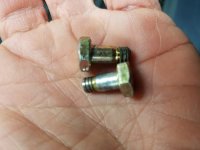aczlan
Good Morning
- Joined
- Mar 7, 2008
- Messages
- 17,540
- Tractor
- Kubota L3830GST, B7500HST, BX2660. Formerly: Case 480F LL, David Brown 880UE
Are you putting this bolt in from the front or from the back? It looks almost like if you put it in from the back the shoulder may line-up into the shear area.Yes, I have the updated shear bolt setup in mine:
View attachment 499062
Here is the bolt in the package from Kubota:
View attachment 499063
The total distance of the two flanges lined up is around 3/4". The thread on the bolt could be 1/4" shorter in my opinion.
View attachment 499064
View attachment 499066
And here is the head of the bolt. This is a grade 8 bolt, right? Seems like no where to step up to other than to go to a 5/16".
View attachment 499065
The last bolt I pulled out had a bit of a bend to it, even though it was only in there a short time. They seem to loosen up quickly. I assume that it is stretching the bolt.
I can get pretty good access to the two sides of the flange. It seems like a good, permanent solution would be to weld up the holes and redrill them, as they are a bit loose right now. I will try and find another grade 8 1/4" bolt with a longer flange (less threads). The JH label on bolt head indicates the Chinese manufacture. Maybe they are not really grade 8 or they have some manufacturing problem?
Aaron Z

